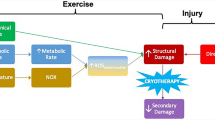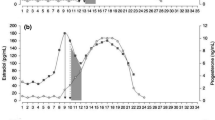Abstract
This experiment was designed to assess the effects of prolonged whole body immersion (WBI) in thermoneutral and cold conditions on plasma volume and hydromineral homeostasis.10 navy “combat swimmers” performed three static 6-h immersions at 34°C (T34), 18°C (T18) and 10°C (T10). Rectal temperature, plasma volume (PV) changes, plasma proteins, plasma and urine ions, plasma osmolality, renin, aldosterone and antidiuretic hormone (ADH) were measured. Results show that compared to pre-immersion levels, PV decreased throughout WBI sessions, the changes being markedly accentuated in cold conditions. At the end of WBI, maximal PV variations were −6.9% at T34, −14.3% at T18, and −16.3% at T10. Plasma osmolality did not change during and after T34 immersion, while hyperosmolality was present at the end of T18 immersion and began after only 1 h of T10 immersion. In the three temperature conditions, significant losses of water (1.6–1.7 l) and salt (6–8 g) occurred and were associated with similar increases in osmolar and free water clearances. Furthermore, T18 and T10 immersions increased the glomerular filtration rate. There was little or no change in plasma renin and ADH, while the plasma level of aldosterone decreased equally in the three temperature conditions. In conclusion, our data indicate that cold water hastened PV changes induced by immersion, and increased the glomerular filtration rate, causing larger accumulated water losses. The iso-osmotic hypovolemia may impede the resumption of baseline fluid balance. Results are very similar to those repeatedly described by various authors during head-out water immersion.






Similar content being viewed by others
References
Arborelius M, Balldin UI, Lilja B, Lundgren CEG (1972) Hemodynamic changes in man during immersion with the head above water. Aerospace Med 43:592–598
Armstrong LE, Costill DL, Fink WJ (1985) Influence of diuretic induced dehydration on competitive running performance. Med Sci Sports Exerc 17:456–461
Boussuges A, Molenat F, Grandfond A, Regnard J, Wolf JP, Galland F, Robinet C (2007) Cardiovascular changes induced by cold water immersion during hyperbaric hyperoxic exposure. Clin Physiol Funct Imagin 27:268–274
Deuster PA, Smith DJ, Smoak BL, Montgomery LC, Singh A, Doubt TJ (1989) Prolonged hole-body cold water immersion: fluid and ion shifts. J Appl Physiol 66:34–41
Dill DB, Costill DL (1974) Calculation of percentage changes in volumes of blood, plasma, and red cells in dehydration. J Appl Physiol 37:247–248
Epstein M (1992) Renal effects of head-out water immersion in humans: a 15-year update. Physiol Rev 72:563–621
Epstein M (1996) Renal, endocrine, and hemodynamics effects of water immersion in humans. In: Handbook of Physiology. Oxford University Press, Oxford, pp 845–853
Gabrielsen A, Pump B, Bie P, Christensen NJ, Warberg J, Norsk P (2002) Atrial distension, haemodilution, and acute control of renin release during water immersion in humans. Acta Physiol Scand 174:91–99
Gordon CJ, Fogarty AL, Greenleaf JE, Taylor NAS, Stocks JM (2003) Direct and indirect methods for determining plasma volume during thermoneutral and cold-water immersion. Eur J Appl Physiol 89:471–474
Greenleaf JE, Shvartz E, Kravik S, Keil LC (1980) Fluid shifts and endocrine responses during chair rest and water immersion. J Appl Physiol 48:79–88
Hammerum MS, Bie P, Pump B, Johansen LB, Christensen NJ, Norsk P (1998) Vasopressin, angiotensin II and renal responses during water immersion in hydrated humans. J Physiol 511:323–330
Hardy JD, Dubois EF (1938) Basal metabolism, radiation, convection and vaporization at temperatures of 22°C to 35°C. J Nutr 15:477–492
Harrison MH, Graveney MJ, Cochrane LA (1982) Some sources of error in the calculation of relative change in plasma volume. Eur J Appl Physiol 50:13–21
Hope A, Hjelle J, Aanderud L, Aakvaag A (2005) Time and temperature effects on body fluid loss during dives with the open hot-water suit. Aviat Space Environ Med 76:655–660
Jimenez C, Melin B, Koulmann N, Allevard AM, Launay JC, Savourey G (1999) Plasma volume changes during and after acute variations of body hydration level in humans. Eur J Appl Physiol 80:1–8
Johansen LB, Foldager N, Stadeager C, Kristensen MS, Bie P, Warberg J, Kamegai M, Norsk P (1992) Plasma volume, fluid shifts, and renal responses in humans during 12 h of head-out water immersion. J Appl Physiol 73:539–544
Johansen LB, Videbaek R, Hammerum M, Norsk P (1998) Underestimation of plasma volume changes in humans by hematocrit/hemoglobin method. Am J Physiol 274:R126–R130
Khosla SS, Dubois AB (1979) Fluid shifts during initial phase of immersion diuresis in man. J Appl Physiol 46:703–708
Larsen A, Johansen L, Stadeager C, Warberg J, Christensen N, Norsk P (1994) Volume-homeostatic mechanisms in humans during graded water immersion. J Appl Physiol 77:2832–2839
Melin B (1996) Effects of physical activity and sports on the loss of electrolytes. Supply recommendations. Med Nut 32:205–213
Mourot L, Wolf JP, Galland F, Robinet C, Courtière A, Bouhaddi M, Meliet JL, Regnard J (2004) Short-term vasomotor adjustments to post immersion dehydration are hindered by natriuretic peptides. Undersea Hyperb Med 31:147–154
Nakamitsu S, Sagawa S, Miki K, Wada F, Nagaya K, Keil LC, Drummer C, Gerzer R, Greenleaf JE, Hong SK et al (1994) Effect of water temperature on diuresis-natriuresis: ADH, ANP, and urodilatin during immersion in men. J Appl Physiol 77:1919–1925
Norsk P (1992) Gravitational stress and volume regulation. Clin Physiol 12:505–526
Rim H, Yun YM, Lee KM, Kwak JT, Ahn DW, Choi JK, Kim KR, Joh YD, Kim JY, Park YS (1997) Effect of physical exercise on renal response to head-out water immersion. Appl Human Sci 165:35–43
Robertson GL, Athar S (1976) The interaction of blood osmolality and blood volume in regulating plasma vasopressin in man. J Clin Endocrinol Metab 42:613–620
Rochelle RD, Horvath SM (1978) Thermoregulation in surfers and nonsurfers immersed in cold water. Undersea Biomed Res 5:377–390
Shiraishi M, Schou M, Gybel M, Christensen NJ, Norsk P (2002) Comparison of acute cardiovascular responses to water immersion and head-down tilt in humans. J Appl Physiol 925:264–268
Sramek P, Uliny B, Jansky L, Hosek V, Zeman V, Janakova H (1993) Changes of body fluids and ions in cold-adapted subjects. Sports Med Training Rehab 4:195–203
Stocks JM, Patterson MJ, Hyde DE, Jenkins AB, Mittleman KD, Taylor NAS (2004) Effects of immersion water temperature on whole-body fluid distribution in humans. Acta Physiol Scand 182:3–10
Zambraski EJ (1990) Renal regulation of fluid homeostasis during exercise. In: Gisolfi CV, Lamb DR (eds) Cooper, carmel. Perspectives in exercise science and sports medicine. Fluid homeostasis during exercise, vol 3. pp 247–280
Acknowledgments
The authors thank M. C. Aguilon, N. Clerc, C. Vincent, J. Gototte, S. Terretaz, J. Vincent, N. Tordi, J. Denis and V. Leroux for the excellent technical assistance. The authors extend their thanks to the volunteers whose participation made this study possible. The authors would like to acknowledge the support of Direction Générale de l’Armement. We would also like to thank Frances Sheppard of the Clinical Investigation Center of Besançon for her linguistic assistance.
Author information
Authors and Affiliations
Corresponding author
Rights and permissions
About this article
Cite this article
Jimenez, C., Regnard, J., Robinet, C. et al. Whole body immersion and hydromineral homeostasis: effect of water temperature. Eur J Appl Physiol 108, 49–58 (2010). https://doi.org/10.1007/s00421-009-1187-2
Accepted:
Published:
Issue Date:
DOI: https://doi.org/10.1007/s00421-009-1187-2




